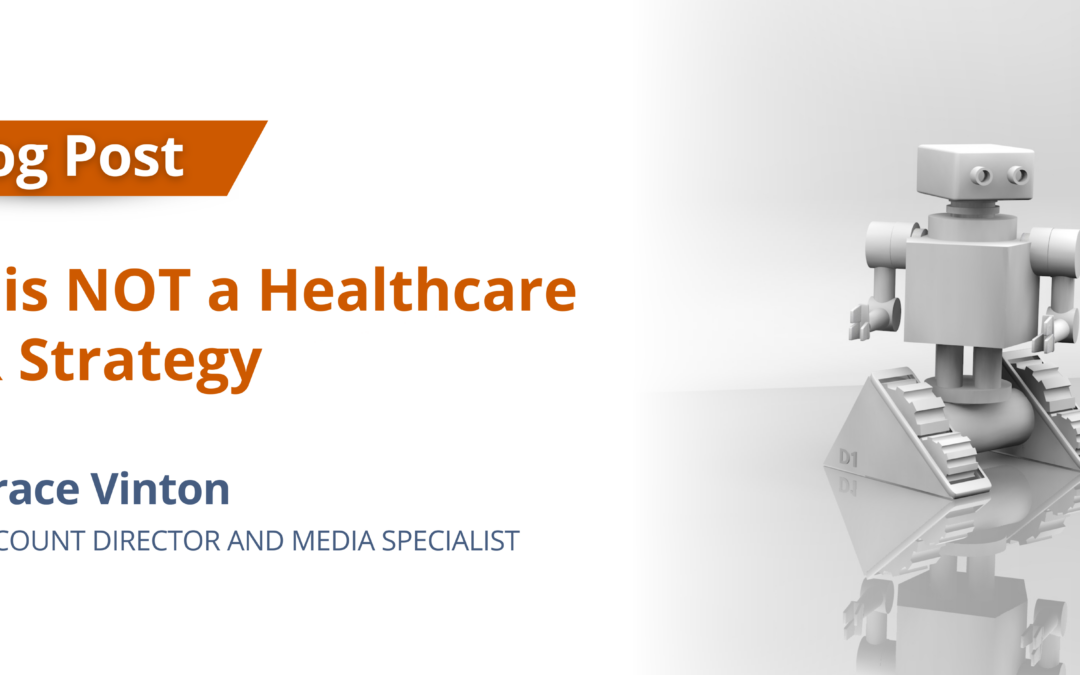
AI is NOT a Healthcare PR Strategy
What does our very own Grace Vinton say about AI?
“AI is not a healthcare PR strategy.”
But Grace also shares where she believes AI can fit in.
Check out what she has to say in this VLOG!

What does our very own Grace Vinton say about AI?
“AI is not a healthcare PR strategy.”
But Grace also shares where she believes AI can fit in.
Check out what she has to say in this VLOG!

Jodi Amendola, CEO of Amendola Communications and Greg Miller, vice president of business development at Carta Healthcare sit down for a fireside chat to discuss navigating the evolving landscape of healthcare marketing and industry events. They explore the changing dynamics of conferences like HIMSS, HLTH, and ViVE, emphasizing the importance of aligning event participation with business objectives and target audiences. The conversation delves into effective strategies for leveraging social media and digital channels to enhance brand awareness, build relationships, and drive growth, all while highlighting the value of a focused and resource-conscious approach in today’s competitive market.

My colleague Philip Anast recently shared some advice from the Wall Street Journal via the Advisory Board regarding situations “where it’s better to slow down at work.”
Let’s be honest: In the hyper-paced world of healthcare public relations and marketing, where there’s a product rollout, speaker submission, or awards deadline around every corner, the notion of “slowing down at work” is downright antithetical. When you’re managing multiple accounts – and trying to make each feel as if they are your highest priority – you instinctively fear that slowing things down will derail your strategic timelines, frustrate your clients, and send your blood pressure soaring. Why make an already intense job even more stressful?
The answer is there are times in PR and marketing where slowing down is essential to doing the best job for your clients, your agency, and your sanity. Here are three situations when slowing down pays off in PR and marketing. These apply to in-house marketing/PR pros, who face pressures similar to those of agency workers.
When you’re the final set of eyes
Marketing and PR pros must create and process high-level, detailed content every day. Thought-leadership bylines, case studies, white papers, press releases, sales sheets, analyst pitches – it never ends. If your client is a life sciences company, you may be writing about concepts that may be ever-so-slightly outside your wheelhouse. That’s OK – you probably didn’t go to medical school, and your yearslong devotion to Grey’s Anatomy will only get you so far.
Still, when you’re delivering content assets, it’s important to get everything right. And no matter how many people look at the “final” draft of a byline, press release, or other public-facing deliverable, someone will be the last set of eyes before the news release is sent to Cision or the byline to your client’s CEO.
Even if it’s the 10th time you’ve read it, do so with intense focus just one more time. Read slowly, scan for typos, and pay attention to flow and impact. This is your last chance! Put another way, if there’s something wrong that you didn’t catch, you may be catching flak from the client, who is paying the agency good money to not mess up content.
When your client wants to do something impulsive and perhaps ill-advised
Clients can be quite emotional. Which is understandable. They’re under pressure on multiple fronts from competitors and investors. They are responsible for executing on product, market, and growth strategies. They’re probably working 70 hours a week. Plus their chief marketing officer just abandoned the company for a new job. And their kids have the flu.
Nonetheless, when the client’s CEO decides what the company needs to do is issue a press release every day for a week before HLTH to carpet-bomb the market into recognizing the pioneering brilliance of their platform (something I heard an investor for a startup insist on), you must slow their roll. Politely but firmly explain how a press release a day doesn’t really align with the rhythm of how the healthcare tech media operates – “Company X made a big splash today. I can’t wait to see what they’ve cooked up for tomorrow!” said no tech reporter, ever – and that it also would be a waste of money. (The money message eventually got through to the investor.)
Similarly, if a CEO wants to confront that editor from Healthcare IT News who omitted the company from a roundup of startups to watch in Sector Z in the coming year and clearly harbors a grudge against us, you must counsel restraint. Emphasize the importance of cultivating long-term relationships with the media, analysts, and others in the industry ecosystem who could help the company down the road. Just giving your excitable clients some time to vent often is enough to defuse a mini-crisis.
When there’s a full-blown PR crisis
Sometimes an actual crisis will arise – your client’s product is the subject of a recall or warning, a customer files a major lawsuit, an investigative article in the mainstream media that mentions the company in a negative light blows up on social media, etc. You’ve got to move fast or things will quickly spin out of control!
Making a public statement that can be easily contradicted, however, will only worsen the problem. Thus, it is imperative that you know the facts. Make sure you take the time to gather all the facts surrounding the issue and are interpreting them correctly. You only have one chance to respond the first time to a crisis. Make it count.
Conclusion
In the PR and marketing biz, you need to think fast and move fast. Sometimes, though, slower is better.

Sometimes you say what everybody is thinking. And when that happens, the reaction can be tangible and immediate.
I was a member of a panel at the recent HIMSS conference and was talking about misinformation. At one point I observed, “Healthcare has a B2B problem, but it’s not business to business; it’s boring to boring.”
All of a sudden everybody started snapping their fingers. I hadn’t seen this reaction before and asked whether people were trying to get my attention. It was confusing! Someone said, “No, you’re on fire.” It seems they agreed with what I said and wanted me to keep going, but didn’t want to interrupt me by clapping. Hence the snapping.
That interesting cultural moment wasn’t about me, but about an awareness clearly shared by most healthcare PR and marketing professionals: Healthcare technology companies and their buyers are mired in boredom. Boring problems. Boring solutions. Boring conversations.
The sad reality is that both healthcare technology companies and their customers – providers, payers, and third parties – are afraid to express a strong opinion or point of view for fear of losing business opportunities.
We’re all sick of boring. Still, I get it: Clients don’t want to confuse or concern a potential customer by saying something audacious or expressing bold thoughts. Healthcare tech companies want to focus their message on what their product does and the problems it can solve for customers. No point in straying from focused thought leadership.
While I understand the strategic impulse toward boring, companies that want to stand out from their competitors need to get more creative with their messaging without confusing buyers or pigeonholing the company as providing a specific solution to a specific problem. Otherwise they may continue to float anonymously in a sea of boring.
Below are some tips for healthcare marketing and PR pros to help their clients and organizations inject some personality and perspective into their messaging.
Connect on a human level
This is healthcare. By definition, it’s about people; serving people and connecting with people. One of the best ways to connect with people is to tell a compelling story. People love hearing stories and are drawn in by a narrative arc that features a journey with highs and lows, challenges and triumphs, and lessons learned.
Great storytellers are relatable and interesting and thus able to connect with an audience. Their stories create a whole world that provides context, rather than running an audience through a tedious list of specific product features and use cases. To sell your product, tell your story.
Go multimedia
Storytelling is about more than the written word. Audio and video are powerful mediums for healthcare technology companies to tell their stories. Not only do some audience members absorb information more efficiently through multimedia, allowing them to see and hear the people behind a healthcare technology company leverages that human connection we all seek.
Even a great infographic or data visualization provides a multimedia tool that can help you articulate a story and emphasize key points. Audience members have diverse learning styles and digital literacy skills; adding a multimedia element to your message will broaden its reach.
Initiate and be part of a conversation
Rather than just relentlessly pumping out marketing collateral, healthcare technology companies should strive to be thought leaders in their sector. Having a voice in an ongoing conversation establishes credibility and puts a human face on the company. Healthcare is a mission-based career, so advocating for your mission and what you believe in resonates with a like-minded audience. People don’t follow companies; they follow other people with great ideas.
Bylined articles published on respected healthcare websites are a great vehicle for demonstrating sector expertise and thought leadership. When potential buyers think you really “get” their challenges, they’ll remember you and your company.
Social media also provides an excellent platform for conversations and idea exchange. LinkedIn probably is the best for healthcare professionals, though many also actively use X. Healthcare technology leaders also can connect with their community through organizations like HIMSS or CHIME.
Finally, some healthcare technology companies have been successful in using podcasts to tell their stories. Some are even launching their own podcasts to provide another venue for interacting with an audience.
Speak the truth (with humor)
The great comedians find humor in everyday life. They also find humor in the truth. If healthcare technology leaders speak the truth to their audiences and find a way to inject humor into the message, they will stand out from the crowd. Humor that is informed by a deep understanding of the industry and the challenges of a particular sector can be memorable. If your humorous truths support your value proposition, all the better.
Conclusion
Healthcare technology companies that hide in the herd and play it safe get ignored. To rise above the boring noise and get your message across, you need to inject your marketing and PR initiatives with a strong storyline framework that employs passion, humanity, humor, and a distinctive voice. Sincerity sells because it’s real and conveys a compelling message: We’re all in this together.

To be successful in business, you have to come up with a viable idea, develop it, bring it to market, and sell it to customers. That may be an oversimplified version of the formula but the basic principles are there: craft a product or service and then spend most of your time selling it far and wide.
As with so many things in healthcare, this process is more complicated than usual. Caring for patients is always the top priority but then there are also so many different stakeholders and revenue streams that muddle how a company should explore expansion.
Ultimately, healthcare executives are the guiding force that can bring an organization to the next level by embodying the mission statement, promoting value to the market, and winning over skeptics.
But in an era where the playing field is so flat, where new markets emerge only to experience a sudden rush of competitive saturation, companies have to stand out. The most obvious answer to an executive might be to rely on standard business strategies to address these challenges.
However, I would argue that the best way to differentiate yourself as a company and secure necessary industry credibility is to operate above the fray.Optics matter, so leaders must recognize that opportunities to interface with the media and stakeholders as a vendor-neutral voice of reason are an effective, proven way to better serve the business.
Casting yourself as an industry authority or subject matter expert pays dividends down the line because outsiders can look at you and realize you have more to say than simply reciting the same sales pitch over and over.
In the years I spent as a healthcare reporter, some of my most valuable contacts in the industry were accomplished executives that could speak to specific events or general trends in a vendor-neutral way.
Neither me nor my audience needed to know about how their RCM company was the best at streamlining the financial experience for patients or how their virtual care service was going to be the Holy Grail of care access. Quality journalists aren’t there to hand out superlatives or write puff pieces about executives and the companies that they run; rehashing a press release isn’t why reporters do what they do.
However, soliciting the opinions of healthcare’s movers and shakers never goes out of style. For example, if there’s a significant policy announcement affecting payers and I can get an insurance executive on the phone to talk about ramifications without reminding me that they were the first to offer certain benefits to members, then that’s a source I can reliably turn to again down the line.
Subtlety, rather than outright salesmanship, is the best way to position your organization for maximum opportunity.
Getting your name in print, on industry panels, or invited to deliver keynotes should always be the goal because then you build a natural rapport with the audiences you’re most seeking to connect with. Everybody wants what they say to have merit and thought leadership is the ideal exercise to make that happen.
Perhaps most importantly to note, you and your company don’t have to be the star of the story; you just have to be in the story.
Since the initial outbreak of COVID-19, healthcare innovation has enjoyed prime media coverage, the likes of which hadn’t been seen before. Whether it was telehealth, remote patient monitoring, or vaccine research, there were thousands of stories printed about fast-moving developments in an industry that has historically been averse to change.
In each of the stories that ran on television, in print media, or on podcasts, there were ample opportunities for leaders to chime in about the future of healthcare. Many participated, but I implore those who didn’t to reconsider their approach to promoting their brand.
If there’s an outlet or reporter asking to associate your name with a trending story or a noteworthy event, even one that likely will not give you the sole spotlight, you’re better off accepting that invitation because now you’re linked to it.
I know there’s a strong inclination to use any and every media appearance to preach the company’s gospel, but there’s an even stronger value in looking at the world from a 30,000-foot view. If you can step outside yourself and speak to topics that are not simply related to your company’s latest announcement, you will gain invaluable industry credibility and media contacts that will return to you without hesitation.
Thought leadership is not just a pie-in-the-sky buzzword for the most outgoing executives in healthcare, it’s a useful strategy to expand brand awareness that every leader and their communications teams should be pursuing if they haven’t done so already.